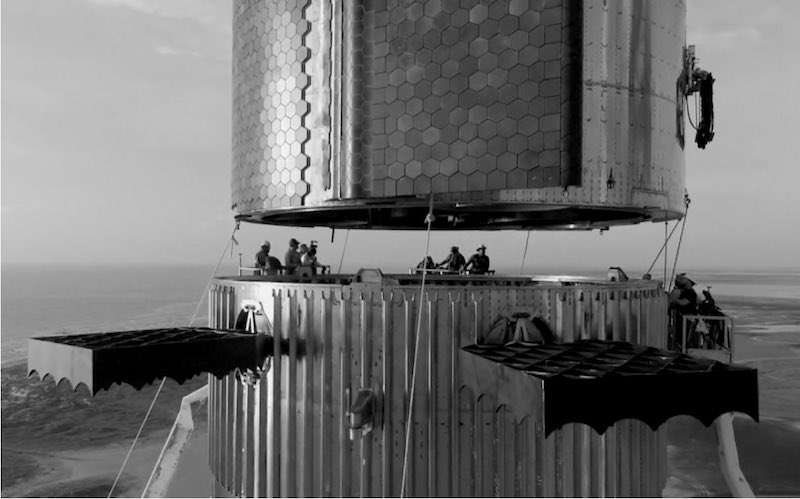Starship stacking produces world’s tallest rocket
Earlier this month, SpaceX briefly stacked its latest Starship prototype on top of a Super Heavy rocket booster. The exercise gave us a glimpse of the scale of what’s now being called the world’s tallest rocket, taller than the giant Saturn V rockets that propelled the Apollo astronauts to the moon in the late 1960s and early ’70s. Engineers performed the stacking test on August 6, 2021, at the private company’s Starbase facility in South Texas.
Elon Musk – SpaceX founder and CEO – said on Twitter it was his “dream come true” to see the vehicle stacked for launch. And the process – and fully stacked rockets – are impressive, as you can see in the video above.
The Starship stacked on August 6 was SpaceX’s SN20 (Serial Number 20) prototype. By itself, it measures around 160 feet (49 m) tall. The Super Heavy booster to which Starship was secured – known as Booster 4 – by itself stands at 230 feet (70 m) tall. Together, they soar a towering 390 feet (120 m) into the sky. For comparison, NASA’s Saturn V rocket stood 363 feet (111 m) tall. And if the launch stand is taken into account, the number grows to about 475 feet (145 m) high, taller than a 40-story building. Do you feel small yet?

Capturing the action
There was no official SpaceX livestream of the stacking, but NASA Spaceflight and Spadre captured the action on their 24/7 live cams of the testing site. Spaceflight communicator Tim Dodd, popularly known as the Everyday Astronaut, also caught the excitement on video following a tour of Starbase last week. Watch a crowd gather, clap, and cheer for the mighty stacking in the video here.
SpaceX hasn’t taken to Twitter to share any official comments with the public. But Musk has shared plenty of photos on Twitter. After writing that the two stages are “fully stacked,” he added that it’s “an honor to work with such a great team.”
An honor to work with such a great team
— Elon Musk (@elonmusk) August 6, 2021
Three rather fascinating pictures came earlier in the week. One included the big Super Heavy crane lift and an up-close look at the 29 Raptor engines fitted to its base.
Moving rocket to orbital launch pad pic.twitter.com/zZLiXIPD6M
— Elon Musk (@elonmusk) August 4, 2021
Testing before takeoff
Starship prototypes have flown before. In May, for instance, the SN15 model aced a 6-mile-high (10-km-high) test flight, which soared upward and then returned to Earth, landing upright. Super Heavy has yet to fly, but SpaceX aims to change that soon.
When that day will come, though, remains unforeseen at the moment. The Starship spacecraft and Super Heavy booster need essential testing on their thermal shields and other equipment before they’ll be ready for liftoff. SpaceX is also awaiting a review of its launch operations by the U.S. Federal Aviation Administration, and there’s no word yet on when that will be finished.
Musk has also shared that at least “four significant items” are required for the two to be fully operational. On Twitter, he mentioned some final heat shield tiles, thermal protection of the engines, and more ground propellant storage tanks. According to CNBC, Starship also needs a quick disconnect arm, which connects power and fuel lines to the rocket before launch. He concluded his comments with: “2 weeks.”
4 significant items:
– Final heat shield tiles for ship
– Thermal protection of booster engines
– Ground propellant storage tanks
– QD arm for ship2 weeks.
— Elon Musk (@elonmusk) August 6, 2021
Starship: Moon, Mars and beyond
It’s clear that SpaceX expects Starship and Super Heavy to be up and running soon, and who could doubt it? The date often mentioned for the final system to be fully operational is 2023.
SpaceX calls Starship a two-stage “fully reusable transportation system designed to carry both crew and cargo to Earth orbit, the moon, Mars and beyond.” NASA has chosen this system as the moon lander for its crewed Artemis program, intended to carry the first man since the 1970s, and the first woman ever, to the moon. That decision has been publicly fought and criticized by SpaceX’s competitor, Blue Origin, which claims that Starship’s refueling launches are “a danger to NASA’s lunar mission integrity.” Nevertheless, NASA has maintained its selection and shot for boots on the lunar surface by 2024 during Trump’s presidency. President Biden – after one year in office – has still not committed to a timeline.
Bottom line: SpaceX briefly stacked its latest Starship prototype on top of a Super Heavy rocket booster on August 6, 2021, giving a glimpse at the scale of what’s now called the world’s tallest rocket. Engineers performed the stacking test at the company’s Starbase facility in South Texas.
Read more from EarthSky: SpaceX Starship prototype soars 6 miles up, then lands upright











